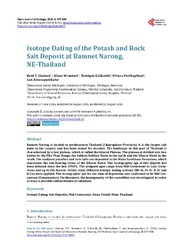Isotope Dating of the Potash and Rock Salt Deposit at Bamnet Narong, NE-Thailand
Zeitschrift: Open Journal of Geology, 201606, 08: 875 - 894
DOI: https://doi.org/10.4236/ojg.2016.68067
Persistent URL: http://resolver.sub.uni-goettingen.de/purl?gldocs-11858/6708
Persistent URL: http://resolver.sub.uni-goettingen.de/purl?gldocs-11858/6708
Hansen, Bent T.; Wemmer, Klaus; Eckhardt, Monique; Putthapiban, Prinya; Assavapatchara, San, 2016: Isotope Dating of the Potash and Rock Salt Deposit at Bamnet Narong, NE-Thailand. In: Open Journal of Geology, Band 06, 08: 875 - 894, DOI: 10.4236/ojg.2016.68067.
 |
Dokument öffnen: |
Bamnet Narong is located in northeastern Thailand (Chaiyaphum Province). It is the largest salt
mine in the country and has been mined for decades. The landscape in this part of Thailand is
characterised by a low plateau, which is called the Khorat Plateau. The plateau is divided into two
basins by the Phu Phan Range, the Sakhon Nakhon Basin in the north and the Khorat Basin in the
south. The analysed potashes and rock salts are deposited in the Maha Sarakham Formation, which
represents the salt-bearing strata of the Khorat Basin. The stratigraphic age of this deposit has
been debated since the late 1960’s. The assigned ages range from Mid-Cretaceous to Late Cretaceous
and up to the Eocene. In this study different isotopic dating systems (Rb-Sr, Sr-Sr, K-Ar and
K-Ca) were applied. The stratigraphic age for the time of deposition was confirmed to be Mid Cretaceous
(Cenomanian). Furthermore, the homogeneity of the carnallites was investigated in order
to trace a possible redistribution of rubidium.
Statistik:
ZugriffsstatistikSammlung:
- Geologie [930]


